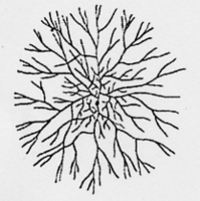Turning real fungi into cyberfungi
Fungi are neither animals nor plants, so it should not be surprising that the fungal cell differs in many respects from both these other Kingdoms of eukaryotes.
The fundamental cellular component of fungi is the hypha, which is a polarised cylindrical structure with a chitinous cell wall [for a full explanation click on this hyperlink to see Chapter 5: Fungal cell biology of our 21st Century Guidebook to Fungi].
Kinetic analyses of living fungi show that fungal filamentous growth can be interpreted on the basis of a regular cell cycle, and the essential starting point for any attempt to develop an understanding of the mathematics of fungal networks is a clear statement of the most crucial hyphal growth rules characterising that cycle in living fungi. These are as follows:
- Extension growth occurs only at the hyphal apex;
- Cross walls always form at right angles to the long axis of a hypha;
- Nuclear division is not necessarily linked to “cell” division;
- Formation of hyphal branches is the only way to increase the number of growing points.
An important biological consequence of these rules is that, for the fungi, hyphal branch formation is the equivalent of cell division in animals, plants and protists. The position of origin of a branch, and its direction and rate of growth are the main formative events in the development of fungal tissues and organs.
The crucial observation is that a fungal mycelial hypha has a number of alternative developmental pathways open to it:
- continuation of hyphal growth;
- production of asexual structures;
- progress into the sexual cycle.
These are alternatives for individual hyphae. Different members of the hyphal community of a mature mycelium may express different developmental pathways, so the community as a whole can express all of these possibilities at the same time. This is interpreted to mean that genetic control must be localized.
There is also evidence that indicates that normal morphogenesis is made up of independent developmental subroutines for each major tissue and/or organ type.
- These subroutines can be put into operation independently of one another;
- they are under separate genetic control,
- and separate physiological control.
In many respects, therefore, the fungal mycelium can be viewed as a very mechanical biological system and on the next page we will show you how we can start to put together the mathematical interpretation of this system.
Copyright © David Moore 2017
